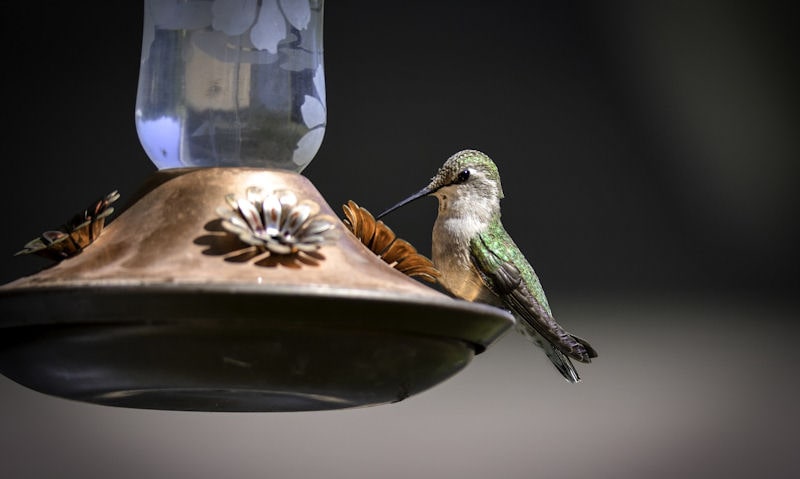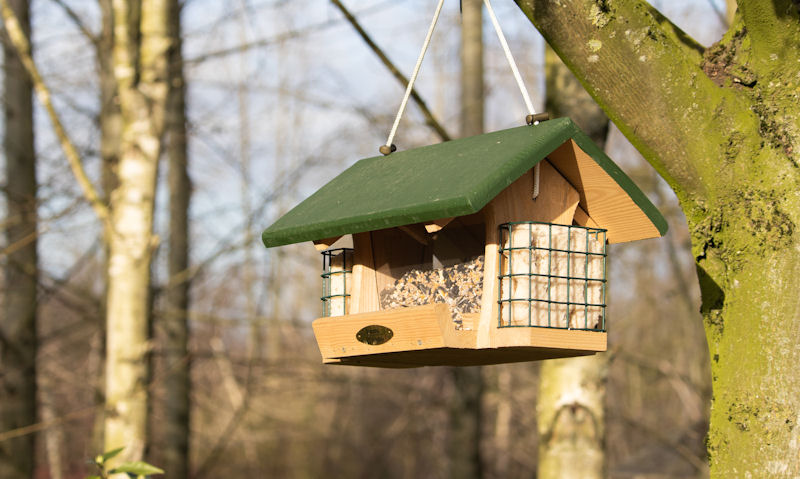5 tips for hanging bird houses
Be aware the hanging of a bird house can reduce the likelihood of birds nesting, fewer than it is, and in doing so it only applies to few species that prefer a tree location.
Tips for hanging a bird house is limited to a tree placement only. Up to 2 hanging points must be assembled to prevent movement, while the second point is the fail safe, in case the bird house is to fall. Reduce hang length to stabilize, by leaning the bird house on top of a branch or against the tree trunk.
Remain mindful of a hanging bird house continuing to swing if you don't stabilize it, to which birds will never use a moving bird house in a million years.
Birds that do nest in a bird house will do so if its mounted to a tree; thus to hang the bird house can still see success with the many birds that would nest, is now reduced only to a few bird species - including but not limited to Bluebirds, Titmice, House Finches and Sparrows.
Bird houses made to hang is more of a novelty and therefore not a requirement of any bird house build. Whilst you must remain hopeful you'll see success, in the end you may have to revert back to mounting the bird house if you see no interest.
When hanging the bird house in a tree only, correct positioning must be considered with how high the bird house must hang, according to the species needs - while picking a spot that is accessible at all times.
Bird houses can come crashing down to the ground with occupants still inside, so I ask you to fix an additional length of wire, independent of the hoop for hanging in case it fails.
In doing so you can avoid the bird house swinging or spinning in mid air, although to push the bird house up against a tree trunk - with an option to hang a bird house on a tree limb - can stabilize the box. You can also sit a bird house on top of a branch or a group of branches, which is just as effective and a better way to hang bird houses.
Hang a bird house that has a color scheme that matches the hanging environment where it hangs, as a vibrant bird house can attract all kinds of pests and predators, where it will absolutely stand out in what is a natural, leafy surrounding.
1. Hang off tree branch only
Personally I can't see you successfully getting any birds to nest in your bird house that is hanging, and that is if its hung up out in the open only as it can be tricky.
Birds prefer a secure box flush against a post or on a tree, thus a hanging bird house can feel unsafe, and so would be ignored for the most part.
Take that into consideration where you hang a bird house as its going to have to remain still; while carefully positioning for the bird species you intend to attract, in their preferred placement in the yard.
To hang a bird house you should only do so to attract birds that nest in boxes that are usually mounted to a tree.
Of the birds this relates to it can be: Bluebirds, Wren's, Chickadees, Woodpeckers, Sparrows, Starlings, Finches and Titmice. Others can be tempted to nest in a hanging bird house - though its guaranteed to be an uphill struggle.
Hang a bird house off a strong tree branch only, far up to the trunk where its the strongest point, yet is the area least likely to break under the weight of the heavy bird house.
2. Space out hanging points
Now, the way you hang a bird house in a tree is going to be a critical moment, to be sure the bird house remains hanging - while avoiding the box crashing to the ground with the occupants still inside.
And I can't say that enough, never give up on securing a bird house off a tree branch until you can be 100% sure it safe and secure.
Nevertheless, you won't ever see birds nest in your bird house unless it remains completely still as it hangs. It has to be said, anything that hangs will indeed swing, though with a bird house this can't be.
Rather than relying on one point to hang then, reply on two areas to hang the bird house.
First you'd screw in two points on opposite sides of each other, with four screws used in total - near to the front and rear, on the top part near the roof.
Wrap around wire to the two screws opposite each other to hook around the branch, then do the same for the screws opposite on the rear. What you will end up with is two hanging points, in which happens to prevent the bird house swinging.
Bonus of that is the two independent hanging wires can prevent the bird house dropping to the ground, if one connection fails.
With that in mind, never depend on a single length wire to hang, in case it fails.
3. Reduce hanging length
Best tip I can offer you when hanging a bird house in a tree, is to be sure the length of wire used is as short as possible.
To allow a bird house to hang at length can create a bit of turbulence as it hangs; thus a shortened length of rope or wire simply takes that disturbance out of the bird house if its hung so far down.
In fact I would avoid going for any length whatsoever [as seen in picture above], with any kind of hanging point from the bird house to the branch being at zero inches.
It would then appear as if the top tip of the bird house roof is in contact with the branch or leaning at an angle on the trunk.
To stabilize a bird house as it hangs off a tree branch, you'd have no other choice then to reduce the length at which it hangs.
What you can do at this point is if there continues to be movement of any kind, is to use an additional length of wire or rope to screw on the bird house where you see fit. Then proceed to fasten it around an additional branch or the tree trunk to prevent movement.
4. Lean to stabilize
Who say's the bird house has to hang at all? And if you insist on hanging, at least you can do is give the effect of hanging.
Bird houses won't be used by any bird if it spins, swings or moves a bit; thus to strongly consider these events definitely happening with your bird house, you must think outside the box.
Rather than allow a bird house to fully hang at any length then, why not push the bird house up against the tree trunk, or stable it on top of a tree branch.
In theory your bird house will still be hanging via a tree branch above, only the bird house sitting on top of a branch is going to stabilize it, with birds then feeling safe to use it.
In addition to that, lean the birdhouse against the tree trunk; it must be flush so the wire to hang may need to be tied around the trunk itself, to give you that flush position.
Fully hanging bird houses won't remain stable, so to hang the bird house above a branch while still in contact can keep it absolutely still. With an option to push the bird house as far way up the branch as possible, to allow it to lean on the tree trunk itself.
5. Material used to hang
What is going to be the strongest, most durable material used to hang a heavy wooden bird house - would be galvanized wire or wire coated in plastic.
Wire is the only safe material used to hang up heavy-duty bird houses, so I ask you to give made in fabric rope a miss, as in time it will corrode. Rope will wear in time so the likely event would be the bird house comes smashing down to the ground.
To use wire isn't without its drawbacks for sure, whilst wire is unlikely to cut through the object it tied or hopped over - the object instead may eventually weaken as its not as tough as wire.
When hanging a bird house within the cover of a tree, I recommend to always make sure the points on the bird house are metal, such as steel screws to cope with the wire that can cut like cheese wire.
Similarly, the bird house wire would be tied or hooped over or around a branch or the trunk; why not then place a bit of fabric between the branch and the wire.
What this will do is prevent the wire digging into the branch, leading to trouble down the road. To revert to a similar wire plastic coated clothesline, the soft plastic coating will provide this protection for you.


